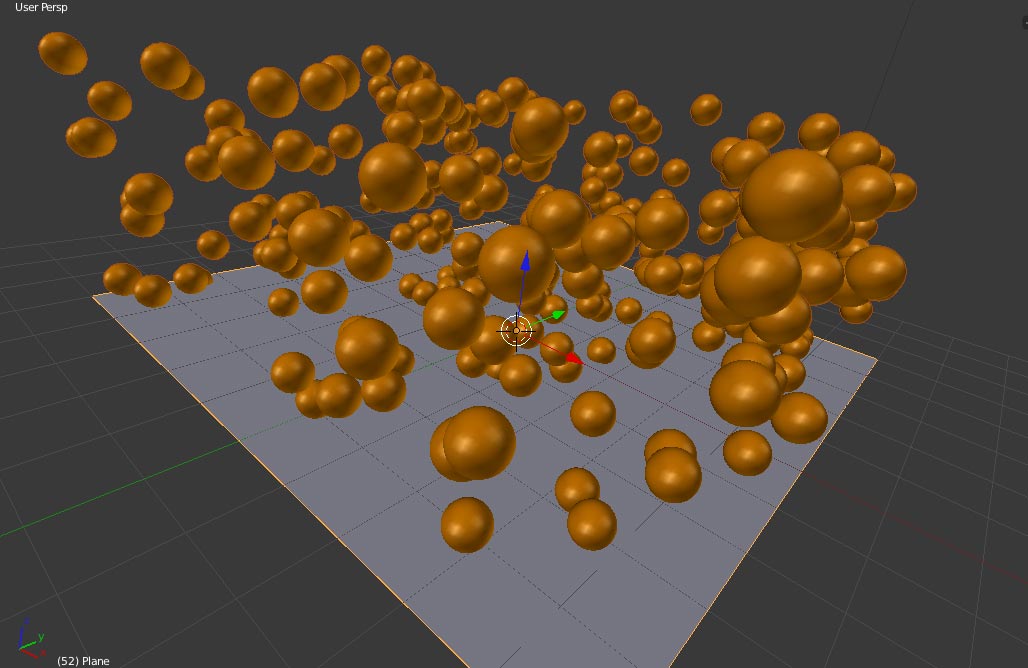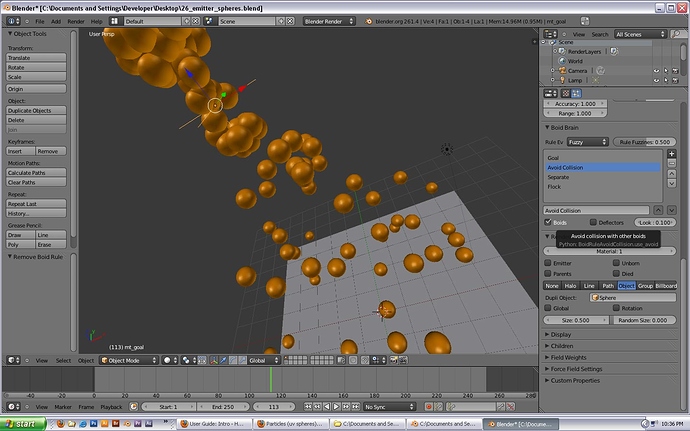I didnt find any option to adjust that overlapping. Anyone can help? Here is screen:
No one know how to fix that?! No way :eek:
I really need help with this.
I don’t think there is really a fix for that. Not an automatic fix, that is. The particle system is not physics aware of the shape if its neighbors. All you can do is try to scale the spheres down and play with the size and distribution options.
Attachments
26_emitter_spheres.blend (733 KB)
I tried adding Soft Body physics to the sphere used as particle object, to test collision options, and while each particle collides with other objects, it does not respond to collision with its fellow particles. Tried a number of settings for this but still got many intersections and particles meeting one anothers’ paths did not react with collision. One of the problems is that the particles often spawn in proximity less than the sphere radius, so even collision would not keep them separate. If you’re using any kind of randomness in the spawning parameters, this will probably always happen.
Ok, thanks.
Tried Boids physics? Should work if you make the brain set to avoid.
-rking
P.S.: I know I’m being terse… let us know if you need a leg up on implementing what I said.
What are you actually trying to achieve ?
Are the spheres stationary? are they moving (how) ? are they falling ? etc etc etc
@rking: Boids is a good suggestion, but they don’t work either. Even though I have given them a rule to avoid other boids, they still collide with themselves. Seems like a missing feature.
Attachments
Hi DSkitter.
I am not very experienced with 3D in general or Blender so take my advice with a grain of salt.
The “Force Field Settings” panel within a particle system seem , at least, to be able to de-mingle particles from one another. The settings within this panel give each individual particle a Force type. The panel has a “Self Effect” option that causes each particle’s force to effect any other particles within that particle system. I would think that if the Strength and Maximum limit were set low and just right it might produce the results your looking for.
I am not experienced enough to find the correct settings within a comfortable time frame so I am just - guessing - that the “Force Field Settings” could possibly solve your problem - I really am not sure, and it’s late anyways, I’ve got to go to sleep.
I am interested, though, to here a professional’s perspective on this matter…
Good night.
EDIT:
I’'ve not yet researched how the following features affect or improve simulations with - Force -interactions, but here is a list with some suggestions /comments next to each.
- “Cache Step” size - the lower the more accurate the simulation
_ - Baking - AFAIK, Baking somehow is necessary sometimes, why, I don’t yet fully know:confused:
Maybe I just need to research and experiment with Baking a little more.
_ - Integration algorithm - RK4 is the slowest, but also enhances stability within a simulation
_ - Subframes - increasing these can improve quality. There is also an auto subframe option next to Subframes.
I don’t know whether or not you are knowledgable of any of these features, but I figured that they may require some tweaking/enabling for this particular scenario; since your dealing with such close proximities.
Remember the BGE. It is the place for Rigid Body physics, which is what you seem to want. You will probably have to get clever with bricks or python to make the spheres spawn like particles, but it will work.
-rking
@WiseLyons: That is a good suggestions as well and it does help quite a bit. When you switch from Newtonian to Boids, however, you have to add a goal because you loose the velocity Normal. So while the force fields do prevent most collisions, as the boids collect around the goal collisions are still present. I think if you keep the goal in motion, so boids can not gather around it, it might just work.
Attachments
26_emitter_boids_collision_spheres.blend (577 KB)
I suppose this, my second, post is redundant because the original poster has probably already figured a way to resolve his problem by now, but just in case he hasn’t or someone else encounters this overlapping problem, I am going to post my findings. Also… What the heck…
I took your blend file and set the - first - force field settings to
- Strength: 27
- Flow: 10 ( to alleviate some of the subsequent bounce)
- Maximum: (Enabled) 0.6
-----------------------------------------------
EDIT: You may not even need to use the second force “Type 2:”(mentioned below). I just set the “Power” (falloff power) of the “Type 1:” to ~4.8, and it seemed to alleviate the bounce fairly well. Although there was still a little overlapping.
------- - - - - - -
Then in order to further alleviate some of the subsequent bounce I set the - second - force field settings to
- Strength: 0
- Flow: 10
- Maximum: (Enabled) 0.6
These settings seemed to seperate the particles fairly nicely. Of course, I didn’t check to see how these force fields would affect any particular simulation, so I don’t know.
@DSkitter I don’t know what Physics type your using, but I tried the “Force Field Settings” method to seperate overlapping particles with both a Newtonian and Boids Physics type, and, for me, they worked really well.
Good night.



